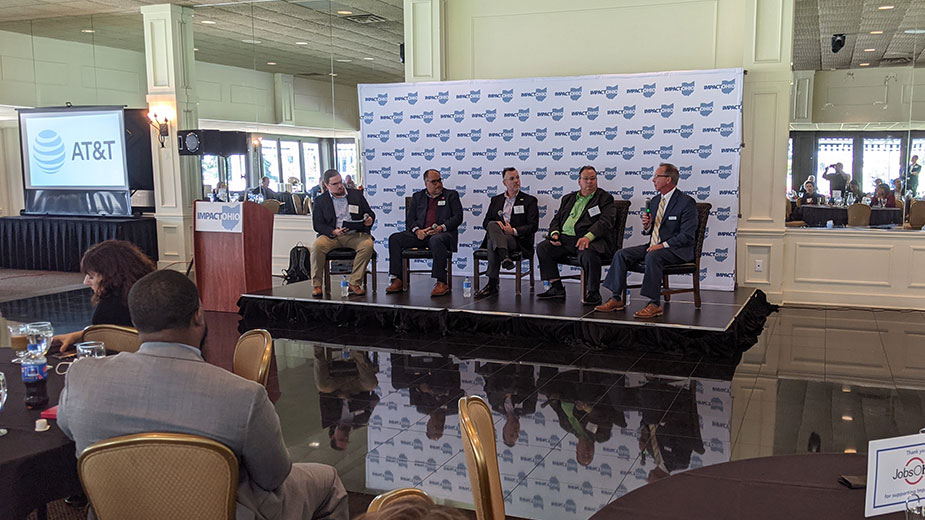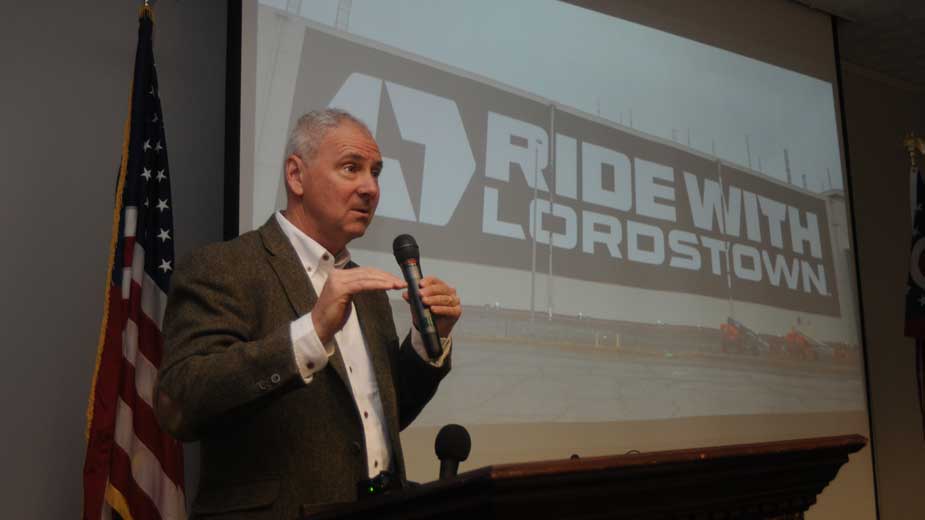Smart Logistics Hub Makes Valley Part of ‘Major Paradigm Shift’
WARREN, Ohio — As auto manufacturers begin to produce more electric vehicles, leading to connected vehicles and autonomous vehicles, Mahoning Valley residents will likely see these changes first-hand.
“We’re part of a major paradigm shift in regards to transportation,” said Brian Kelley, chief technology officer for the Ohio Turnpike and Infrastructure Commission. “The gasoline engine is now going to disappear. GM and Ford and all the other major auto manufacturers have now signaled that, and they’re making a major investment in electrification.”
This transition puts the Mahoning Valley in a unique position to court the companies that are also positioning themselves for that paradigm shift and looking for a place that brings everything together, he said. Projects in Lordstown and the Voltage Valley play a strategic role.
Kelley shared his thoughts on a proposed smart logistics hub during a panel discussion at the 2021 Impact Ohio Mahoning Valley Regional Conference, which took place Friday at The Grand Resort. He was joined by Jonathan Bridges, manager director of Automotive, Steel and White Goods at JobsOhio; Jim Kinnick, executive director of the Eastgate Regional Council of Governments; and Luke Stedke, manager director of communications and policy for DriveOhio. Justin Dennis, reporter for Mahoning Matters, moderated the panel.
The paradigm shift Kelley spoke of is not just happening locally, but throughout the country. He cites trends in turnpike traffic as an example. While overall traffic declined during the pandemic, commercial traffic “it way up right now over last year” as more people make online purchases. The number of Amazon Prime trucks traveling the turnpike has increased, he said.
“There’s still a lot of supply and logistics problems right now in the world and United States,” Kelley said. “Which makes me wonder what it’s going to be like when things get back to normal.”
The Mahoning Valley is a strategic location in the Midwest, connecting the Northeast and the West, he said. So it plays an important role in the overall picture of logistics and distribution, thus is a good candidate for a smart logistics hub.
“We have the opportunity to be just as significant in this paradigm shift as Detroit was in the early 1900s,” Kelley said.
Lordstown, in particular, is a “natural fit,” said Jim Kinnick, executive director of the Eastgate Regional Council of Governments. After General Motors ceased operations at its former Lordstown assembly plant, a study looking at how to recover from the loss of the auto industry identified ways to diversify the local economy. The findings included electric vehicles, logistics, information technology and additive manufacturing, Kinnick said.
“[Smart logistics] really follows the guidelines of the recovery plan and the opportunities to diversify,” he said.
The goal of smart logistics is to employ electric, connected and autonomous vehicle technology to improve the efficiency of travel while reducing wear and tear on vehicles and infrastructure, all while creating jobs, courting investment for innovation and improving safety.
When identifying opportunities, planners need to consider what provides the best value for the area, Kinnick said. Intermodal terminals, for example, include truck and rail connectivity, allowing freight to be removed from trains and loaded onto trucks for distribution, he said.
“That was one of the components we originally looked at and still are looking at,” he said.
A $500,000 planning and research grant from the state allowed Eastgate to bring on a team of experts to identify the best opportunities for the area, he said. In addition to electric vehicles and logistics, having a strong broadband network is among those opportunities.
In the next six months, the team will present its recommendations and direction, Kinnick said.
The broadband aspect coincides with the turnpike upgrading all of the fiber equipment along the entire 241-mile stretch, Kelley noted. That project will likely begin at the end of this year and be completed in 2022.
Once opportunities are identified and agreed upon, it’s important for all involved to develop an aggressive plan to show federal and state agencies that plans can be executed quickly, Kinnick said. Such plans are necessary to ensure grant monies are properly spent so the area can court more money.
“Federal and state money is out there if you have a plan,” he said. “If they’re going to give you money, you better be able to spend it in the next couple of years.”
The idea of smart logistics puts the Mahoning Valley on the forefront of the transition into a new economy, JobsOhio’s Bridges said. Large-scale employers in the electric vehicle market, such as Lordstown Motors Corp. and Ultium Cells LLC, as well as major distribution centers such as the TJX HomeGoods center in Lordstown and the Macy’s Inc. center in North Jackson, will benefit from the smart logistics hub, which will be vital in supporting the technology and suppliers coming into the region to supply those companies.
“That supply chain does not exist in North America,” Bridges said. “What is being established here is going to feed the rest of the U.S., potentially Canada, maybe Mexico as well.
“It’s creating a story that we want around Voltage Valley. The name says what’s going on here.”
Being early adopters of smart logistics is not without risk, he allows. He cited workforce challenges as an issue. But through the planning process, those involved are identifying those issues and coming up with solutions so the Mahoning Valley and Ohio can be “what other states and cities will look to as help,” he said.
“So, you’re either paralyzed by the fear of the future, or you’re living in the present and you’re focused on the future,” Kelley said. “What we’re doing here in the Mahoning Valley is really positioning ourselves and focusing on the future, what’s coming next.
Part of what comes next is connected vehicles, such as autonomous or semi-autonomous trucks able to connect wirelessly to one another, he said. The lead truck maintains the speed, direction and braking for one or more trucks behind it, allowing the convoy to travel more efficiently using less energy.
Innovation in the consumer vehicle market will also tie into the smart logistics hub, Kelley said. Connected vehicles are increasingly becoming all of the vehicles coming off of assembly lines have anywhere from 70 million to 100 million lines of software code in them.
Next year, every Ford vehicle coming off the line will have built in technology that will allow Ford vehicles to communicate with each other, he said. In 2023, GM vehicles will be able to update their software over the air.
“Technology will allow vehicles to be able to communicate in traffic lanes,” he said. “And to share information on safety. This is going to charge transportation as we know it.”
Regardless of market or industry, when considering how to innovate and move the needle forward, one of the through-lines is partnership, said DriveOhio’s Stedke.
“It takes like-minded innovators to come together,” he said. “We are watching in real time the development of a new transportation system.”
With that comes new forms of last-mile delivery and new connectivity, in terms of innovation and people, he said. When speaking with companies looking to come to Ohio, Stedke said one of the things they are most interested in is seeing long-term working relationships between cities and counties within the state.
Initial projects will help stoke interest.
In the spring of 2022, Eastgate’s Kinnick expects to launch an autonomous shuttle downtown as part of the Smart2 – Strategic & Sustainable, Medical & Manufacturing, Academic & Arts, Residential & Recreational, Technology & Training – Network project.
What will become only the second such shuttle in the state is already drawing interest from potential vendors in that industry, Kinnick said.
“The attention that it brought the area as forward-thinkers in this region and as a city is certainly paying dividends,” he said. “And that’s how we grow our effort; grow our initiative.”
In-road EV charging is also a possibility, he said, and they’re eyeing the split-interchange in Lordstown as a way to test it out. Such technology puts the wires in the road for about a quarter-mile. As vehicles go over it at 25 miles-per-hour, “you pick up enough charge to go another 100 miles,” he said.
Among the challenges ahead of regional partners is site readiness, said Eastgate’s Kinnick. Partners are looking for ways to accelerate that to ensure land is ready for businesses looking to move here.
The region must also be ready to react quicker and cheaper than competing areas when it comes to meeting the needs of businesses, particularly with utilities.
Pictured: Justin Dennis of Mahoning Matters moderates The Future of The Lordstown Smart Logistics Hub panel discussion, with panelists Jonathan Bridges, managing director of Automotive, Steel and White Goods at JobsOhio; Luke Stedke, managing director of Communications and Policy at DriveOhio; Brian Kelley, chief technology officer for the Ohio Turnpike and Infrastructure Commission; and Jim Kinnick, executive director of the Eastgate Regional Council of Governments.
Copyright 2024 The Business Journal, Youngstown, Ohio.



